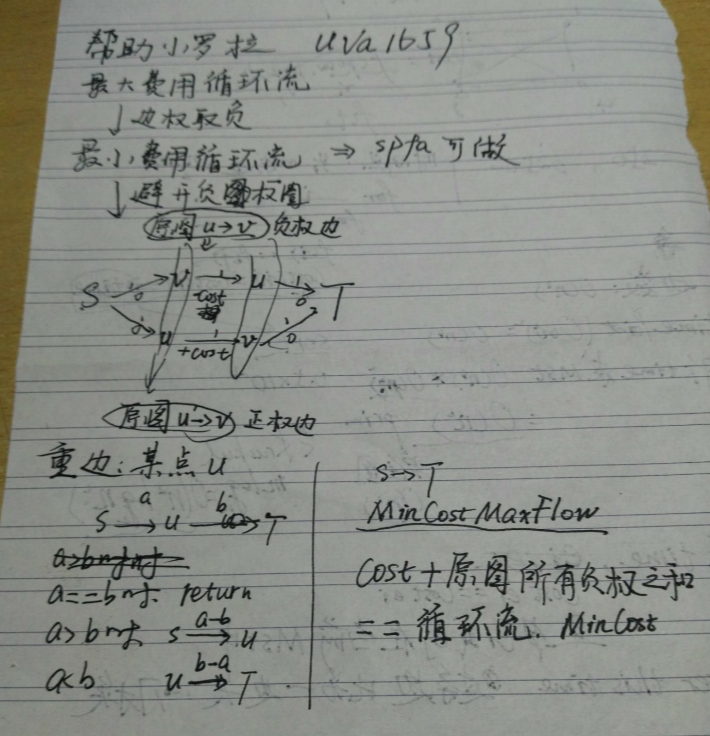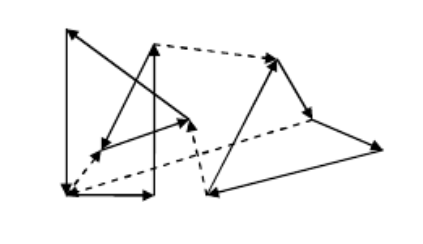题意:平面上有m条有向线段连接了n个点。
你从某个点出发顺着有向线段行走,给走过的每条线段涂一种不同的颜色,最后回到起点。
你可以多次行走,给多个回路涂色(要么不涂色,要么就至少给一个回路上的边全部涂色)。
可以重复经过一个点,但不能重复经过一条有向线段。
如下图所示的是一种涂色方法(虚线表示未涂色,即每次都可以从任意点出发染色)。
每涂一个单位长度将得到X分,但每使用一种颜色将扣掉Y分。
假设你拥有无限多种的颜色,问如何涂色才能使得分最大?
输入保证若存在有向线段u -> v,则不会出现有向线段v -> u。
n <= 100,m <= 500,1 <= X,Y <= 1000。
对于坐标(x,y)0 <= x,y <= 1000。
思路:看刘汝佳的方法,还没有深入理解。
http://blog.csdn.net/u013368721/article/details/30553815
http://www.cnblogs.com/xcw0754/p/4659201.html
要求的就是最大费用循环流(即每找到一个环就可以进行增广)。找环可能并不复杂,但是要找一个最大的环就有点复杂了,所以用网络流解决。又因为找的是最大费用,按老套路的话会出现无限增大费用的情况,所以要先将每条边的费用取相反数(前面加个负),才可以有机会求最小费用流。而这些边的权有正有负,取完之后也可能出现负环了,所以主要问题就是解决负环。
用最小费用流求最大费用循环流时,解决负环的一种方法:
(1)先将所有边权取反。
(2)建边。正权值的边容量为1,费用为权值。负权值的边u->v拆成3条边,
分别是S->v,v->u,u->T,容量都为1,v->u费用为负权的相反数,其他2条费用为0。
这样会出现某个点有多条边连到S或T,可以互相抵消到一方为0为止,统计剩下多少条k,将其中1条的容量设为k,其他的全部删掉。如果全部抵消掉了,那就将连S和T的边全部删掉。(这个删边的方法有技巧)
(3)跑一次最小费用流得到的总费用,加上所有负权之和之后(注:此时答案已为负的),再取反即得到最大费用。
删边技巧是,在建这S->v,v->u,u->T 三条边时,先建中间那条,统计该点连到S几次,减去连到T点几次,结果若为正,则与S连一条边,容量就是几次,若负,同理。
至于why it works!得好好想想~
画几个点验证了一下发现,如果一个原图中的环(权值大于0)值得取,那么流会自动流向该环原图中的负权边。而如果不值得取,那么会流向原图中的正权边。因为我们是用sum(负值)加上那个费用(正值),所以当该环要取时,则自动减去那些负权,不取呢,会自动减去那些正权(而那些负权的完全没取到)。不懂就画个环出来验证吧。
===========================
一开始用lrj的vector的方法存边,TLE了一发
改成前向星存图,过了,STL还是慢啊
#include<queue>
#include<cmath>
#include<cstdio>
#include<vector>
#include<cstring>
#include<iostream>
#include<algorithm>
using namespace std;
typedef long long LL;
const int N = 2007;
const int INF=0x3f3f3f3f;
const double EPS = 1e-6;
struct MCMF{
struct Edge{
int from,to,cap,flow,nxt;
double cost;
Edge(){}
Edge(int x,int y,int z,int u,double v,int n){
from=x;to=y;cap=z;flow=u;cost=v;nxt=n;
}
}edges[N];
int E,head[N];
int n,s,t,inq[N],p[N],a[N];
double d[N];
inline void Init(int n,int s,int t){
this->n = n; E = -1;
this->s = s; this->t = t;
memset(head,-1,sizeof(head));
}
inline void AddEdge(int f,int t,int c,double w){
edges[++E] = Edge(f,t,c,0, w,head[f]);
head[f] = E;
edges[++E] = Edge(t,f,0,0,-w,head[t]);
head[t] = E;
}
bool spfa(int s,int t,int flow,double &cost){
for (int i=0;i<=n;i++)d[i]=INF;
memset(inq,0,sizeof(inq));
d[s]=0;inq[s]=1;p[s]=0;a[s]=INF;
queue<int>Q;Q.push(s);
for (;!Q.empty();){
int nxt, u =Q.front();Q.pop();inq[u]=0;
for (int i=head[u];i!=-1;i=nxt){
Edge &e = edges[i]; nxt = e.nxt;
if (e.cap<=e.flow||d[e.to]<=d[u]+e.cost)continue;
d[e.to] = d[u] + e.cost;
p[e.to] = i;
a[e.to] = min(a[u],e.cap-e.flow);
if (!inq[e.to]){Q.push(e.to);inq[e.to]=1;}
}
}
if (d[t]==INF)return 0;//false
flow += a[t];
cost += (double)d[t]*(double)a[t];
for (int u=t;u!=s;u=edges[p[u]].from){
edges[p[u] ].flow += a[t];
edges[p[u]^1].flow -= a[t];
}
return 1;//true
}
//需要保证初始网络中没有负权
double mcmf(){
int flow =0;
double cost = 0;
for (;spfa(s,t,flow,cost););
return cost;
}//MinCostMaxFlow
} g ;
struct point{
int x,y,d;//d:Degree
point(){}
inline void read(){scanf("%d%d",&x,&y);d=0;}
}po[N];
vector <int > link[N];
inline double sqr(double x){return x*x; }
inline double dist(int a,int b){
return sqrt(sqr(po[a].x-po[b].x)+ sqr(po[a].y-po[b].y));
}
int main(){
//freopen("in.txt","r",stdin);
int n,dx,dy,x;
for (int cas=0;~scanf("%d",&n)&&n;){
scanf("%d%d",&dx,&dy);
g.Init(n+1,0,n+1);
for (int i=1;i<=n;i++)link[i].clear();
for (int i=1;i<=n;i++){
po[i].read();
for (;~scanf("%d",&x)&&x;)link[i].push_back(x);
}
double ans = 0;
for (int i=1;i<=n;i++){
for (int j=0;j<link[i].size();j++){
double d = dist(i,link[i][j]);
double cost = (double)dy - 1.0*d * dx ;
if (cost>0) g.AddEdge(i,link[i][j],1,cost);
else {
ans -= cost;
g.AddEdge(link[i][j],i,1,-cost);
po[link[i][j]].d++;
po[i].d--;
}
}
}
for (int i=1;i<=n;i++){
if (po[i].d>0) g.AddEdge(g.s, i, po[i].d, 0);
if (po[i].d<0) g.AddEdge(i, g.t,-po[i].d, 0);
}
ans -= g.mcmf()-EPS;
printf("Case %d: %.2lf
",++cas,ans);
}
return 0;
}

